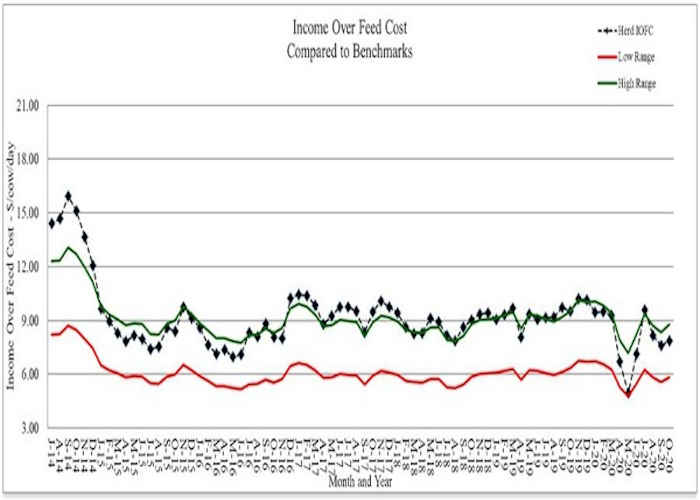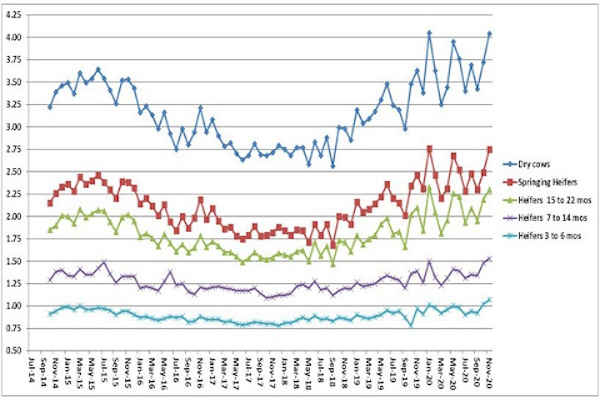By Virginia A. Ishler
Production perspective:
Pennsylvania is unique compared to other regions of the country due to herd size and milk cow facilities. According to the 2017 National Agricultural Statistics Service the average number of milking cows is 76. Tie stall or stanchion barns are commonplace and feeding milk cows conventionally is still prevalent. As the industry continues to move into unchartered territory due to the pandemic, is this feeding approach sustainable?
The Extension Dairy Team works with many component fed herds and the following comparisons excludes intensive grazing operations. Fourteen herds of similar size with half feeding conventionally and half feeding a TMR were evaluated on production and financials from 2019. The component fed herds milked on average 44 cows with 25,081 pounds sold per milking cow compared to the TMR cohorts of 73 milking cows averaging 27,891 pounds sold per milking cow. Both groups had similar milk prices paid in 2019. The component fed herds had $300 less milk income per cow compared to the TMR fed herds. That is not surprising with fewer cow numbers and lower production, but that is only one side of the equation.
Total feed costs were very similar between the two groups. This includes home-raised and purchased for the milk cows, dry cows, and heifers. The component fed herds spent $2,151 per cow compared to the TMR fed herds of $2,247. Since there is almost three thousand pounds less milk volume per cow produced in component fed herds, feeding management may be an opportunity for this group. This would entail the feeding sequence of forages, to grains and energy, to protein feeds to mimic the approach of a TMR. There may be opportunities in the grain feeding schedules for fresh cows and first calf heifers. Component fed herds do not have the ability to feed numerous commodities and tend to feed a complete grain mix or high moisture corn and a protein supplement. Their advantage is feeding the individual animal compared to group feeding with a TMR in free-stall housing
The total out flow between the two feeding approaches was almost identical at $4,000 per cow. This includes feed cost, dairy and operating expenses, owner draw, and loan payments. Controlling expenses does not appear to be the problem when comparing the different feeding approaches. Milk production and milk income is the bottleneck for conventionally fed herds, which is illustrated by their breakeven income over feed cost of $9.10 per cow compared to the TMR fed group of $8.68 per cow. Another metric to use is the gross milk price breakeven, where the component fed herds need $20.56/cwt compared to $18.42/cwt for the TMR herds to cash flow.
Improving milk income by increasing milk production is not a simple task. Housing and cow comfort could be major factors limiting dry matter intake. Many of the tie stall or stanchion barns are antiquated and have not been updated in decades. Correcting inadequate stall size and ventilation are major expenditures. Another challenge with small herds relates to small acreage. Multiple cuttings of hay-crop forage can result in dramatic changes in quality throughout the storage structure making it difficult to adjust rations in a timely fashion. This can hinder lactating cows from receiving consistent diets and the correct amount of nutrients, especially energy and protein, over time.
Milk income appears to be the greatest threat to sustainability of Pennsylvania’s smaller sized farms, regardless of feeding approach. Increasing cow numbers to increase production is not an option for cows housed in tie stall or stanchion barns. Herds utilizing a TMR are reaping the benefits of slightly better production and a more competitive income over feed cost. However, there is probably opportunity in component fed herds to revisit basic feeding management concepts to improve animal performance. With the unknowns associated with the pandemic and weather conditions on the markets, focusing on feeding management in conventionally fed herds would appear to be a smart strategy.
Economic perspective:
Monitoring must include an economic component to determine if a management strategy is working or not. For the lactating cows, income over feed cost is a good way to check that feed costs are in line for the level of milk production. Starting with July 2014’s milk price, income over feed cost was calculated using average intake and production for the last six years from the Penn State dairy herd. The ration contained 63% forage consisting of corn silage, haylage and hay. The concentrate portion included corn grain, candy meal, sugar, canola meal, roasted soybeans, Optigen and a mineral vitamin mix. All market prices were used.
Also included are the feed costs for dry cows, springing heifers, pregnant heifers, and growing heifers. The rations reflect what has been fed to these animal groups at the Penn State dairy herd. All market prices were used.
Income over feed cost using standardized rations and production data from the Penn State dairy herd.

Note: October’s Penn State milk price: $18.03/cwt; feed cost/cow: $6.74; average milk production: 81 lbs.
Feed cost/non-lactating animal/day.

Source : psu.edu